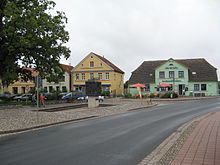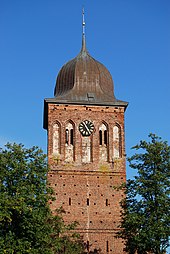Went
| coat of arms | Germany map | |
|---|---|---|

|
Coordinates: 54 ° 27 ' N , 13 ° 16' E |
|
| Basic data | ||
| State : | Mecklenburg-Western Pomerania | |
| County : | Western Pomerania-Ruegen | |
| Office : | West Ruegen | |
| Height : | 6 m above sea level NHN | |
| Area : | 21.66 km 2 | |
| Residents: | 1262 (Dec. 31, 2019) | |
| Population density : | 58 inhabitants per km 2 | |
| Postal code : | 18569 | |
| Area code : | 038305 | |
| License plate : | VR, GMN, NVP, RDG, RÜG | |
| Community key : | 13 0 73 028 | |
| LOCODE : | DE GNS | |
| Office administration address: | Dorfplatz 2 18573 Samtens |
|
| Website : | ||
| Mayoress : | Gerlinde Bieker | |
| Location of the municipality of Gingst in the district of Vorpommern-Rügen | ||
Gingst is a municipality in the district of Vorpommern-Rügen on the island of Rügen in Mecklenburg-Western Pomerania (Germany). The municipality is administered by the West-Rügen Office with its seat in the municipality of Samtens .
geography
Gingst is about 12 kilometers northwest of Bergen on Rügen on the Koselower See bay . Upstream of the community is the island of Ummanz . Gingst borders the Vorpommersche Boddenlandschaft National Park .
Districts
The districts belong to the municipality:
|
|
In addition, the settlements and residential areas are located in the municipality:
|
|
history
- Went
Before 1937, a pile-dwelling settlement from the Neolithic was found during peat work in the Gingster pastorate moor. Pointed poles 3 m long were pulled out of the moor, several vessels and shards were secured from finds, stone tools were found but not kept. The vessels, however, were very remarkable. Prof. Petzsch (University of Greifswald) carried out the excavation and securing in 1937.
The Angerdorf Ghynxt was first mentioned in a document in 1232. Along with Garz and Bergen, it was one of the most important market towns on Rügen and was an important center for craftsmen, especially damask weaving on the island.
The place was part of the Principality of Rügen until 1326 and then the Duchy of Pomerania . With the Peace of Westphalia of 1648, Rügen and thus also the area of Gingst became part of Swedish Pomerania . In 1815 Gingst came to the Prussian province of Pomerania as part of New Western Pomerania .
As early as 1774, the provost Johann Gottlieb Picht abolished serfdom for the portion of Gingst (half of the village) belonging to the preposition .
In the history of the community there have been repeated major fires; In 1726 and finally in 1950, Gingst was almost completely destroyed.
On August 25, 1950, the place went up in flames and a total of 38 houses were destroyed , aided by the wind direction and widespread thatched roofs . A memorial stone on the market has been commemorating this fire and the hitherto unique reconstruction campaign with 10,000 members of the FDJ and other helpers since May 1, 1976. It was created by the Stralsund sculptor Hans-Peter Jaeger. Four bronze reliefs show scenes of the fire and the reconstruction.
Since 1818 Gingst belonged to the district of Rügen . Only in the years from 1952 to 1955 was it part of the Bergen district. The community then belonged to the Rügen district in the Rostock district until 1990 and became part of the state of Mecklenburg-Western Pomerania in the same year. The district of Rügen, which has been called this again since 1990, was merged in 2011 in the district of Vorpommern-Rügen.
Since 1994, the historic town center has been extensively refurbished as part of urban development funding.
- chapel
Kapelle is a Wendish round village with a knightly estate. The estate belonged to the von Platen family . The manor house was built in 1843/44 and extensively rebuilt in 1914.
politics
coat of arms
The coat of arms was approved by the Ministry of the Interior on July 15, 1999 and registered under the number 192 of the coat of arms of Mecklenburg-Western Pomerania.
Blazon : “Split by green and gold; in front an overturned golden sword with round quillons, to each of which a hanging golden weighing pan is attached; behind a red weaver's shuttle placed on a pile, which is covered with fallen and opened red scissors. "
The coat of arms was designed by Gerhard Koggelmann from Sagard .
flag
The flag is evenly striped in gold (yellow) and green across the longitudinal axis of the flag cloth. In the middle of the flag, two thirds of the height of the flag and one third of the length of the golden (yellow) and green stripes, is the municipal coat of arms. The length of the flag is related to the height as 5: 3.
Attractions
→ See also the list of architectural monuments in Gingst
- late Gothic St. Jacob Church (built around 1300), redesigned in Baroque style after several fires (last in 1726)
- Atonement from Gingst behind the church
- Memorial to the fire of 1950 and the reconstruction campaign
- Organ of the builder Kindt from 1790 in the Jacobikirche
- " Rügenpark " leisure park ; Miniature park in which you can see replicas of the most famous buildings in the world. There is also a petting zoo, whitewater rondelle, giant slide, scooter, trampolines and other play facilities.
- Handicraft museum with old cane cages and agricultural equipment exhibition
- Rectory, half-timbered house from 1738 on a field stone base with a mansard roof and bat dormers and two frontispieces on the back. The interior room layout is still original.
- Manor Haidhof, one-storey plastered building with two-storey central buttress and partial hip - mansard roof from the early 19th century
- Manor Chapel: Neo-Baroque , two-storey, 13-axis plastered building from 1844 with turrets and mansard roof; Estate u. a .: families from the east (since the 16th century), von Platen (1816–1839) and von Esbeck and Esbeck-Platen (1935)
Transport links
The federal highway 96 runs east of the municipality. Gingst is connected to the central location of the island, Bergen on Rügen , by bus lines. The bus stops are: Gingst, Gingst Matkt, Gingst Schulhof, Gingst Miniature Park and Gingst Expansion.
Personalities
Sons and daughters of the place
- Samuel Christoph von Tetzloff (1738–1810), councilor in Swedish Pomerania
- Christoph Gottlieb Bogislav von Barnekow (1740–1829), head forester and landowner in Teschvitz
- Adolph Wilhelm Picht (1773–1857), Evangelical Lutheran clergyman
- Joachim Nicolas Eggert (1779–1813), composer and conductor, member of the Royal Swedish Academy of Music
- Wilhelm Wöhler (1814–1884), Protestant clergyman and composer
- Wilhelm Nindemann (1850–1913), Arctic traveler
Other personalities
- Adolph Christoph von Aken (1713–1768), Evangelical Lutheran clergyman and author, from 1753 provost in Gingst
- Johann Gottlieb Picht (1736–1810), Evangelical Lutheran clergyman and social reformer, provost in Gingst from 1769
Web links
Individual evidence
- ↑ Statistisches Amt MV - population status of the districts, offices and municipalities 2019 (XLS file) (official population figures in the update of the 2011 census) ( help ).
- ↑ a b c main statute of the municipality of Gingst from December 8, 2014. (PDF; 2.4 MB) Gingst community, January 9, 2015, accessed on April 11, 2016 .
- ↑ Geodata viewer of the Office for Geoinformation, Surveying and Cadastre of Mecklenburg-Western Pomerania ( information )
- ↑ Lehmann / Meyer, “Rügen AZ”, Wähmann-Verlag, Schwerin, 1976, p. 34







